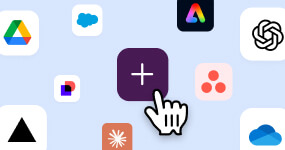In project management, flowcharts are useful for mapping out step-by-step processes and plans. They make tasks easier to understand, standardize workflows, and help teams see how everything fits together. Basic flowcharts and cross-functional ones can be great tools for keeping projects on track in any organization.
Let’s dive into some examples, check out the benefits, and go over what each symbol represents.
What is a flowchart?
A flowchart is a visual tool that uses shapes and arrows to lay out the steps, sequence, and decisions in a workflow. It actually originated in the 1940s with the early computing industry, and is now widely used across fields like education, healthcare, manufacturing, construction — even the culinary world.
Flowcharts make planning, visualizing, documenting, and improving processes so much easier. Each shape represents a specific action, while arrows connect these steps to show the flow from one to the next. Unlike dense, text-heavy documents, flowcharts simplify complex procedures into easy-to-follow sequences. For even more detail, process maps can add timelines, inputs, and outputs into the mix.
Benefits of using flowcharts
Flowcharts are important for companies of all sizes because they standardize business processes, helping to boost efficiency, reduce operational costs, and achieve granular goals. When used alongside other types of process-enhancing features, like artificial intelligence and workflow automation tools, flowcharts can really benefit your teams at a micro- and macro-level:
- Clarify business processes: Step-by-step diagrams outline workflows logically, making it easier to train employees, outsource tasks, and understand how to allocate resources.
- Foster teamwork and accountability: A cross-functional flowchart shows interconnected tasks and hand-off points, demonstrating how employee roles affect outcomes.
- Facilitate problem-solving: Flowchart diagrams can highlight inefficiencies, bottlenecks, and unnecessary steps. A visual representation helps pinpoint redundancies and identify areas for improvement.
- Improve decision-making: Certain flowchart shapes represent a decision, followed by steps for various choices. You can laminate simple charts to enhance in-person customer service interactions and use digital ones with organizational tools for back-office decisions.
- Reinforce compliance standards: Flowcharts are valuable for managing information and policies. They can document important data flow for privacy, security, and quality.
Decoding flowchart symbols
To describe a process visually, flow diagrams use shapes and symbols to guide users from the beginning to the end. Basic flowcharts typically rely on five universal shapes, but you can choose any abstract image as long as it’s consistent and understandable.
Here are five standard flowchart symbols and meanings:
- Oval: This indicates the start or end of a process.
- Rectangle: Use a rectangle when the step requires an action or task.
- Diamond: Think of “D” for decision, or use this icon to ask a question.
- Circle: This directs users to an element across the page.
- Flow lines or arrows: These connectors show directional flow to the next step.
Four popular types of flowcharts
There are over a dozen types of flowcharts, from technical illustrations to event-driven process chain (EPC) diagrams.
Let’s take a look at the most common flowcharts:
- Process flowchart: The most versatile diagram, this approach conveys an entire process. For instance, a new human resources employee could use this type of flowchart to get a high-level view of the insurance-claim process.
- Workflow diagram: While process charts offer a broad view, workflow diagrams focus on specifics, like how to file an insurance claim. It’s also an essential step for successful workflow design.
- Cross-functional flowchart: Also called a swim lane flowchart, this method breaks a shared workflow into lanes for each department or role, divided by functional bands. It outlines each workgroup’s tasks and responsibilities and shows how they interact.
- Data flow diagram (DFD): This flowchart shows how information moves through a system. It’s ideal for developing or integrating software and learning how internal and external factors influence movement.
Best flowchart tools
Readability is key to process mapping, and consistency can improve comprehension. The best flowchart software maintains even spacing and integrates with your work operating system for seamless updates and collaboration. Once you brainstorm the initial steps and sequence, you can create a flowchart in a formal flow-charting app or free flowchart builder.
Check out these flowcharting programs:
- Canva: You can use Canva’s free flowchart software on any device to craft a basic flowchart, data flow diagram, or organizational chart.
- Microsoft Word: Create a flowchart diagram in Microsoft Word using Shapes or SmartArt functions. Then, auto-align your drawing space before finalizing.
- Lucidchart: Explore many types of flowchart examples, business process map tools, and project management templates using Lucidchart’s intelligent diagramming solution.
- Slack Atlas: Help teams understand who their colleagues are with Slack’s reimagined employee directory. This tool displays user affiliations, skills, and an interactive org chart, allowing people to quickly access valuable context about colleagues.
Standardize your workflows with flowcharts
Flowcharts provide a visual resource for effective workflows and project management. Whether you’re onboarding team members, assigning projects, creating new processes, or updating org charts, a standardized method creates clarity for your team.
A process map or cross-functional flowchart provides logical steps, while staff directories, or organizational flowcharts, help employees learn about their teammates and their role within the team. Together, these systems promote efficiency and trust — a winning combination for professional teams.






